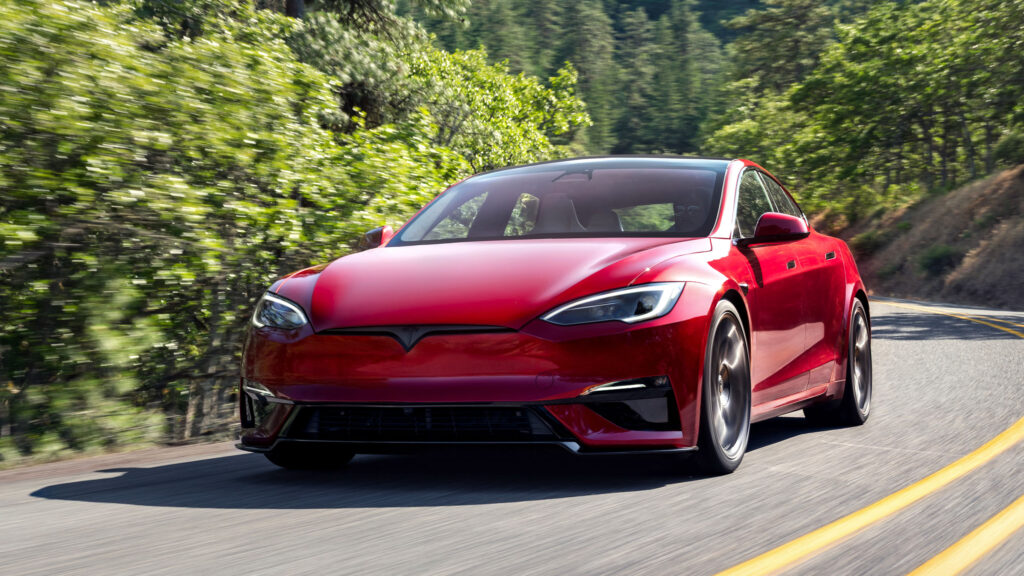Tesla has recently announced the release of the latest refresh of its Model S and X vehicles in the United States. These two models, which have been around since 2012 and 2015 respectively, have received some updates but also come with some surprising changes.
The new Model S and X are now $5,000 more expensive across the board, which has left many wondering why the price hike. Additionally, the top speed of the Model S Plaid has been reduced by 50 mph, which has raised some eyebrows among Tesla enthusiasts.
Despite the price increase and the decrease in top speed, there are some improvements in the new models. The exterior styling has been slightly tweaked, and there have been reductions in wind and road noise, thanks to enhancements in the Active Noise Cancelation technology. The suspension has also been updated to provide a smoother ride, and there is now dynamic lighting in the cabin for added ambiance.
The Model X now offers 2.5 cubic feet more room for third-row passengers and cargo, making it more spacious and versatile. Tesla is also touting a range improvement in the Model S Long Range, with the sedan now able to travel up to 410 miles on a single charge. The Model S Plaid has also seen a range increase, now capable of going up to 368 miles on a full charge.
However, it’s the performance tweaks to the Plaid versions of both cars that have raised concerns. The Model S Plaid now has a top speed of 149 mph, down from 200 mph in its predecessor, and has gained 26 pounds in weight. The Model X Plaid is now 186 pounds heavier than before, weighing in at 5,434 pounds.
While Tesla’s updates to the Model S and X offer some improvements, they may not be enough to keep up with the competition. Rivals in the electric vehicle market have made significant advancements in recent years, leaving Tesla playing catch-up. The price increase for minor upgrades may not be enough to entice buyers, especially with other options available on the market.
In conclusion, Tesla’s latest refresh of the Model S and X brings some welcome changes but also raises questions about the overall value proposition. With competitors pushing the boundaries of electric vehicle technology, Tesla will need to step up its game to remain competitive in the ever-evolving automotive landscape. The world of technology is constantly evolving, with new innovations and advancements being made every day. One such advancement that has been gaining a lot of attention in recent years is the development of artificial intelligence (AI). AI refers to the simulation of human intelligence in machines that are programmed to think and learn like humans.
One of the most exciting applications of AI is its use in the field of robotics. Robotics is the branch of technology that deals with the design, construction, operation, and application of robots. These machines are capable of carrying out a variety of tasks, from simple household chores to complex industrial processes.
With the integration of AI, robots are becoming more intelligent and autonomous than ever before. They are now able to learn from their surroundings, adapt to new situations, and make decisions on their own. This has opened up a whole new world of possibilities for the use of robots in various industries.
One industry that has particularly benefited from the advancements in AI-powered robotics is the manufacturing sector. Robots are now being used in factories to automate repetitive tasks, increase efficiency, and improve overall productivity. They can work 24/7 without getting tired or making mistakes, leading to faster production times and higher quality products.
In addition to manufacturing, AI-powered robots are also being used in healthcare, agriculture, transportation, and even in space exploration. In healthcare, robots are assisting surgeons in complex surgical procedures, while in agriculture, they are helping farmers in tasks such as planting, watering, and harvesting crops.
The integration of AI in robotics has also raised some concerns about job displacement. As robots become more capable of performing tasks that were once done by humans, there is a fear that many jobs will be lost. However, proponents of AI argue that it will create new job opportunities in the fields of robotics, AI programming, and maintenance.
Overall, the combination of AI and robotics is revolutionizing the way we live and work. From manufacturing to healthcare, these intelligent machines are transforming industries and improving efficiency. As technology continues to advance, the possibilities for AI-powered robotics are truly endless. It is an exciting time to be a part of this technological revolution. The world is constantly changing and evolving, and with it, so are the ways in which we interact with each other and the world around us. In recent years, the rise of social media has drastically altered the way we communicate, connect, and share information.
Social media platforms like Facebook, Instagram, Twitter, and TikTok have become integral parts of our daily lives, allowing us to stay connected with friends and family, share our thoughts and experiences with the world, and even discover new ideas and trends. These platforms have also become powerful tools for businesses and organizations to reach and engage with their target audiences.
One of the most significant impacts of social media is the way it has democratized communication. In the past, traditional media outlets like newspapers, television, and radio controlled the flow of information, deciding what news and stories were important and how they were presented to the public. With social media, anyone can become a content creator and share their voice with the world.
This democratization of communication has empowered individuals and marginalized groups to have their voices heard and stories told. Social media has been instrumental in raising awareness about social justice issues, sparking important conversations about race, gender, and inequality, and mobilizing communities to take action.
However, the rise of social media has also brought about challenges and concerns. The spread of misinformation and fake news on these platforms has become a significant issue, leading to confusion, division, and even violence in some cases. The algorithms that control what content is shown to users have also been criticized for creating echo chambers and reinforcing biases.
Despite these challenges, social media remains a powerful tool for connection, creativity, and change. As we continue to navigate this ever-evolving digital landscape, it is essential that we approach social media use with mindfulness, critical thinking, and a commitment to using these platforms for good.
In conclusion, social media has fundamentally transformed the way we communicate and interact with each other. It has given a voice to the voiceless, connected people across the globe, and sparked important conversations about important issues. As we move forward, it is crucial that we harness the power of social media for positive change and work together to create a more inclusive and informed digital world.

